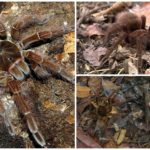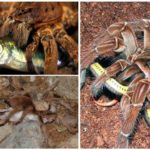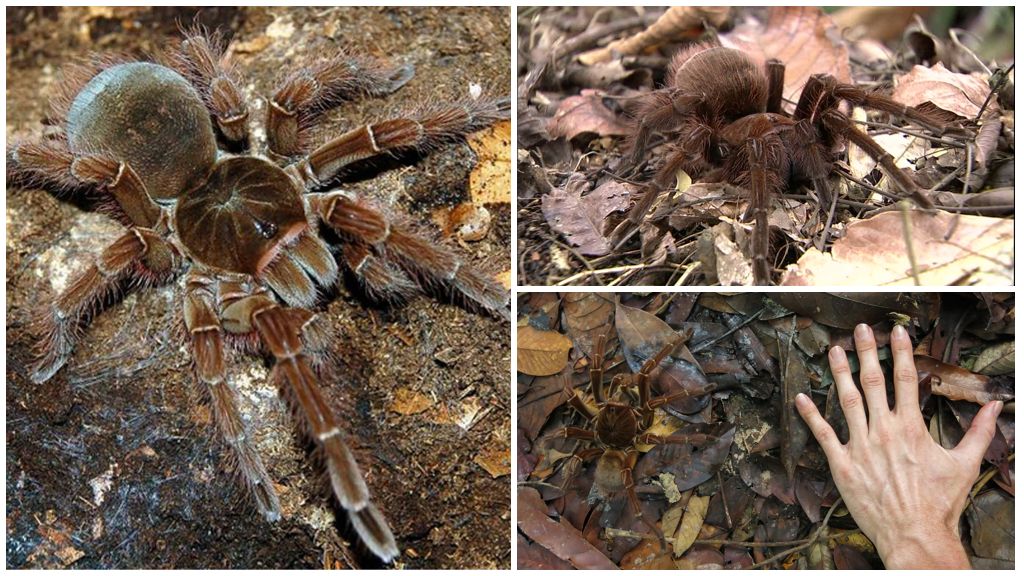Description and photo of the goliath bird spider
Content
- Spider tarantula-goliath
- Goliath Spider Feeding
The goliath spider belongs to the family Theraphosa blondi. Until 2001, it was called the largest arachnid in the world. A specimen with a foot span of 28 cm was discovered in Venezuela in 1965. In early 2000, a new species was discovered in the tropical forests of Laos - Heteropoda maxima. The length of the legs of a spider is 2 cm longer than that of a goliath, but it is inferior in body size and mass.
Description of the appearance of the goliath
The body size of the female is 1 cm, males - up to 70 mm. The span of the limbs reaches 28 cm. The legs are powerful, strong, covered with hairs. Color is light brown or dark. Paws are reddish brown.
The body of the tarantula is all in long, thick hairs.The abdomen is convex, round, protected by dense shell. 8 legs are fastened to the cephalothorax, in the front part there are long pedipalps that look like another pair of limbs, chelicera with canines up to 2 cm. There are 8 eyes on the head, 2 of them are main, looking forward, the others are auxiliary. A photo of the goliath spider is shown below.
Interesting!
Despite the large number of eyes, vision of the tarantula is weak. He sees at a distance of 25 cm. Images are presented to him in the form of shadows, silhouettes. However, goliath responds quickly to movement, the presence of prey is determined by vibrations, smell. Auxiliary eyes help to quickly respond to the approach of the victim, the enemy.
Lifestyle, breeding
The spider tarantula goliath leads a solitary life, it is gathered in pairs only during the mating season. Males determine the presence of females by smell, which she actively distributes. Fights often occur between applicants, but the partner is still chosen by the “lady”.
Interesting!
A hungry female tarantula eats the beau, even before he starts caring for her, so he often brings her a treat. A similar fate awaits him after mating, if he does not have time to escape in time.
After fertilization, the female stops feeding, bears eggs for about 8 weeks. Then it forms a cocoon from a web, lays up to 500 eggs, leaves in a secluded place. It protects the clutch from enemies until cubs appear. After about 2 weeks, spiders appear, crawling apart.
The habitat of the largest tarantula is limited to 4 mills of South America - Venezuela, Brazil, Suriname, Guyana. Settled near water bodies or in a forest with a humid climate. Builds holes in the soil, the entrance protects the web. The depth of the maze reaches 1m.
Nutrition
The goliath bird spider owes its name to the German entomologist, Maria Merian. Traveling to the countries of South America, she saw a picture of how a huge spider was eating a hummingbird. Information got instantly in the press, so attached the name.
The main diet of the goliath spider:
- insects;
- snakes;
- snakes;
- beetles;
- small birds, chicks;
- snakes;
- frogs;
- toads;
- rodents;
- small arachnids.
The predator does not build trapping nets, does not weave a web, prefers active hunting. Moves around, tracks down prey. At the right moment instantly attacks, bites long fangs, injects poison, his own saliva.The first substance paralyzes the victim, the second dilutes the insides. For some time, the goliath spider waits aside, when the victim’s convulsions have stopped, begins to eat.
Hunting in the dark, daytime sitting in a secluded place. This behavior is due to the presence of a large number of natural enemies - the family of feline, canine. Defending itself against the attacker, the birdworm goliath turns backwards towards it, quickly shedding its fine, spiky hairs with poison. While the predator wakes up, the spider crawls away.
Interesting!
The arthropod is able to repair a damaged limb. Initially, it discharges the residues, then sends the liquid there, which eventually turns into a solid formation. The process is long, but in the end a new leg is being formed. Throughout life, the female sheds 5-7 times. In this way, she sheds parasites, increases in size, and renews poisonous wool.
Danger to humans
The tarantula goliath does not differ in aggressive behavior, does not rush to attack at the sight of a person, but his unfriendly attitude betrays a hiss. Bite inflicts solely for the purpose of self-defense.By the strength of the painful sensations it is compared with the wasp, the hornet. For life is not dangerous, but causes some discomfort.
Redness, swelling, and pain appear at the site of the bite. In young children, people with weak immunity, allergy sufferers, there is a worsening of general well-being - dizziness, weakness, headache, nausea, vomiting, fever. The condition is normalized in a few days, antihistamines are taken to speed up the therapeutic effect.









